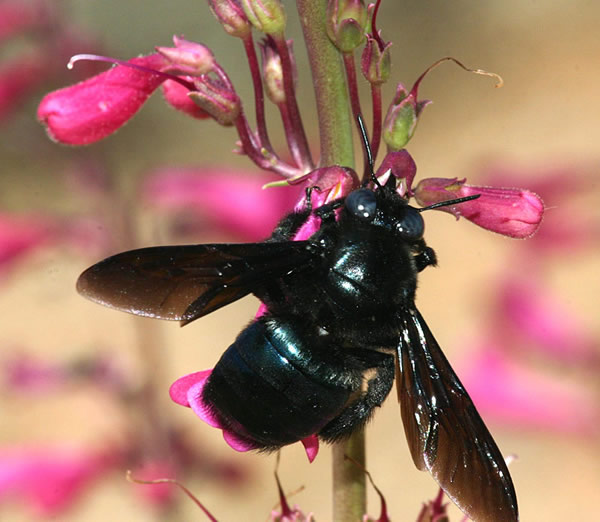At the time, a bee was a bee to me. But perhaps Old George knew one bee from another and he was on to something with that jar thing all those years ago. There are over 4,000 species of bees native to the United States and remember, bees are not wasps and our beloved honeybees were actually imported by our ancestors. They are native to Eurasia. Bees tend to be fuzzy; wasps are sleek and shiny with attitudes.
Each species of bee uses a slightly different method of building their nests and carpenter bees like to chew out perfect half-inch round holes in dead branches and then create horizontal burrows inside the wood to lay their eggs. They construct cell walls out of regurgitated wood pulp, and to them the unpainted, unstained wooden portions of our homes and decks work just as well. Remember, we built our homes in their habitat, so turnabout is fair play.
The U.S. Forest Service says these gentle giants, eastern carpenter bees (Xylocopa virginica), “occasionally take up residence in fence posts or structural timbers, especially redwood, and become a minor nuisance.”
You can spray pesticides on your exposed raw wood to kill or chase them away, but it’ll take multiple treatments that kill more than just your carpenter bees. Besides, they are excellent pollinators of flowers and garden crops like tomatoes.
In May 2020, National Geographic reported in a cover story that “insects were disappearing at alarming rates” at various locations around the planet. In protected areas in Germany alone it’s reported there has been a 76 percent decline, with similar numbers at other locations around the world.
Why? Climate change has altered habitat and population growth has fragmented a lot of what’s left. But you simply cannot talk about insect decline without bringing up insecticides.
Spare the spray
Just this month, NPR’s Scott Simon interviewed Matt Shardlow with the conservation group Buglife in the United Kingdom. Shardlow reports a 60-percent loss in flying insects in just 17 years.
“We’ve banned neonics in the U.K. because they damage bee populations. That is something that in America should be banned tomorrow,” Shardlow said.
Neonics are neurotoxic insecticides. “They permanently bind to insect nerve cells, over stimulating and destroying them — commonly causing uncontrollable shaking or twitching, paralysis, and (eventually) death,” according to the Natural Resources Defense Council.
“It’s outrageous that they’re still using neonics when we know that they’re damaging bee populations.”
What’s the big fuss? Getting rid of most of the flying insects and stinging bees will make our summers more carefree. Except that insects and principally bees pollinate our flowering plants and our food crops. And a large percentage of birds rely on insects, even bees, for their food. A huge loss of insects means a huge loss of birds.
So how do you deal with a few carpenter bees attacking your exposed wood? These bees are typically only active in April and May. That gives you the rest of the year to set up your defenses. Before you drag out a pesticide and run the risk of killing all the pollinating/bird chow insects around your house, focus on the handful of problem bees.
One method is to spray citrus or almond oil on the nest-building site. They hate the smell. You can also stuff cotton balls soaked in isopropyl alcohol into the holes, cram in steel wool and plug with wood putty on a dowel cut to length. Then heavily brush on paint or a paint-based sealant to the area.
Or you can try the good Old George Harvey method: an empty jar. In this case, at the bottom of a carpenter bee trap, a specially prepared wooden box with fake holes drilled into it. Turns out the gentle giants are not that smart.
This is what I have done. And it actually works. Of course I avert my eyes and do not watch the bees slowly die.
